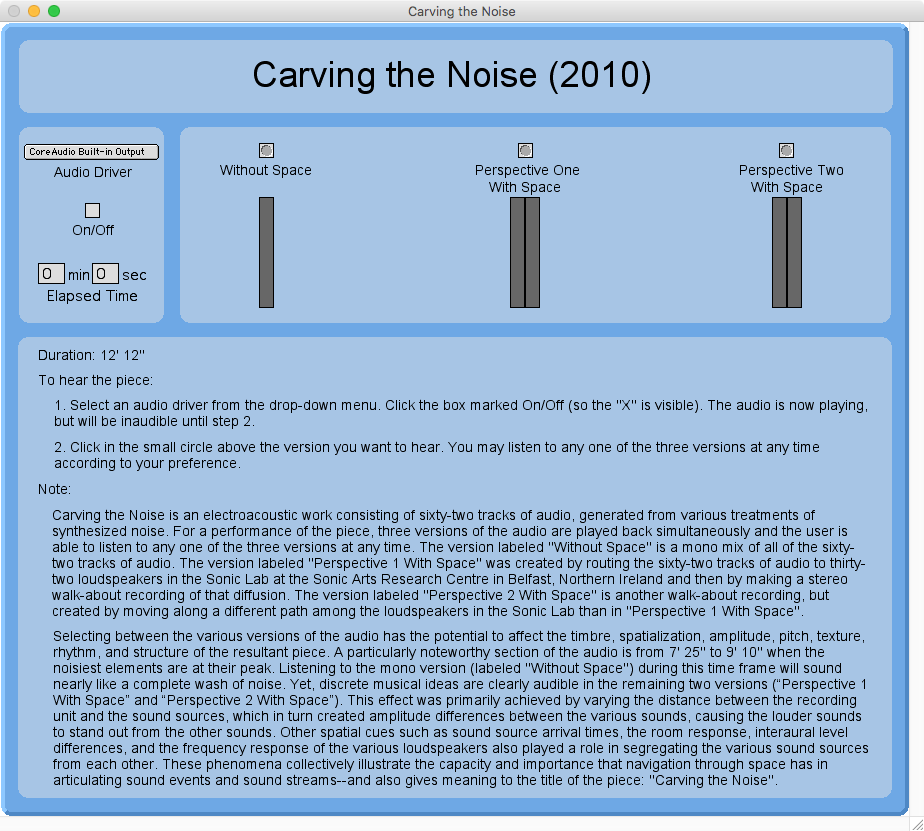Carving the Noise
Carving the Noise (2010) is an electroacoustic music composition controlled from a graphical user interface. The piece is presented to the audience in the form of a computer application.
This is a video of the graphical user interface in use (listening via loudspeakers is recommended, due to the spatial processing used). It shows from 4:30 to 6:00 in the piece (the work is 12:12 in total duration). The interface includes user controls, instructions, and a program note (see below). Three selections are made by the user in the video: “Perspective 1 With Space” (0:00–0:29), “Without Space” (0:30–0:59), and “Perspective 2 With Space” (1:00–1:30).
Program Note
Carving the Noise is an electroacoustic work consisting of sixty-two tracks of audio, generated from various treatments of synthesized noise. For a performance of the piece, three versions of the audio are played back simultaneously and the user is able to listen to any one of the three versions at any time. The version labeled “Without Space” is a mono mix of all of the sixty-two tracks of audio. The version labeled “Perspective 1 With Space” was created by routing the sixty-two tracks of audio to thirty-two loudspeakers in the Sonic Lab at the Sonic Arts Research Centre in Belfast, Northern Ireland and then by making a stereo walk-about recording of that diffusion. The version labeled “Perspective 2 With Space” is another walk-about recording, but created by moving along a different path among the loudspeakers in the Sonic Lab than in “Perspective 1 With Space.”
Selecting between the various versions of the audio has the potential to affect the timbre, spatialization, amplitude, pitch, texture, rhythm, and structure of the resultant piece. A particularly noteworthy section of the audio is from 7:25 to 9:10 when the noisiest elements are at their peak. Listening to the mono version (labeled “Without Space”) during this time frame will sound nearly like a complete wash of noise. Yet, discrete musical ideas are clearly audible in the remaining two versions (“Perspective 1 With Space” and “Perspective 2 With Space”). This effect was primarily achieved by varying the distance between the recording unit and the sound sources, which in turn created amplitude differences between the various sounds, causing the louder sounds to stand out from the other sounds. Other spatial cues such as sound source arrival times, the room response, interaural level differences, and the frequency response of the various loudspeakers also played a role in segregating the various sound sources from each other. These phenomena collectively illustrate the capacity and importance that navigation through space has in articulating sound events and sound streams—and also gives meaning to the title of the piece: Carving the Noise.
This track is from 8:00 to 9:30 in the piece. Similar to the above video, three selections are made by the user in the track: “Perspective 1 With Space” (0:00–0:29), “Without Space” (0:30–0:59), and “Perspective 2 With Space” (1:00–1:30).

Contact me for a download of the entire piece in the form of a stand-alone application.
Photo by Art by Lønfeldt on Unsplash, edited by Moeller.
